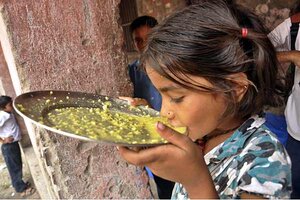Deadly school lunch: India's free meals program under harsh scrutiny
India's free lunch school program is the largest in the world, and until now, much lauded.

An Indian child eats her free school lunch at a government run school in Patna, India, Wednesday, July 17.
Aftab Alam Siddiqui/AP
A day after 23 children in eastern India died from food poisoning, students across the state are reportedly throwing their free meals in the trash, as their parents and other Indians take to the street to protest corruption and lack of oversight of the free meal school program.
India's much-hailed Mid-Day Meal Scheme, impacting some 120 million children, is credited with having improved the school enrollment and child nutrition levels across the country since its mandatory implementation in 2001. But activists and researchers say the tragedy in a provincial city in Bihar state, some 550 miles from New Delhi, reflects systemic problems with the world’s largest school food program that, if not addressed, could ruin the program that millions depend on.
"The government has no monitoring system about the quality of food," says Saurabh Sharma of JOSH, a nonprofit in New Delhi that has been lobbying to improve the quality of mid-day meals since it was formed in 2006.
Despite India’s impressive economic growth, it is still home to approximately one third of all malnourished children in the world, according to the United Nations Children’s Fund. While that number is still alarmingly high, the Mid-Day Meal Scheme has made inroads, and millions of poor families depend on it to provide a hot meal for their children. India’s child malnutrition rate fell more than 10 points to 42 percent in nearly a decade, according to a 2012 report.
Today the government announced it would begin a formal inquiry into what led to the deaths of so many children under the age of 12 and sickened dozens of others, including a cook who tasted the meal.
Early reports say traces of insecticide were found in the food, which experts say may have been in the cooking oil or on cooking supplies. Indeed, government officials found insecticide containers alongside the food allotted to the school's headmistress. A key part of the investigation, she is reported to have left the village with her family.
Some say even if the headmistress is found, it’s the distribution system rife with corruption that is to blame. By estimates in 2012, some 40 percent of subsidized food never reaches the intended recipients, according to the New York Times.
“The school principal will blame the private contractor who will blame the government for paying as little as four rupees [6 cents] per meal," says Mr. Sharma.
The incident sparked a flurry of media reports about children falling ill because of mid-day meals across India, highlighting the fact that the tragedy in Bihar is not an isolated incident. In a neighboring district in Bihar state, 60 students had to be hospitalized after eating the school meals; one is reported to be in critical condition.
Economist Reetika Khera, who teaches at the Indian Institute of Technology in New Delhi, says that a survey conducted recently in 10 states showed the program was popular with children and parents alike. But its success varied from state to state depending on how much governments were spending on it and if they had monitoring mechanisms in place.
"Bihar fares poorly in accountability measures and monitoring of the scheme, and this incident will hopefully make the state get its act together," says Ms. Khera, adding that the increasing role of private players in the program, including contractors, centralized kitchens, and so-called self-help groups is another danger to the program. “Private entities will only come for profit and are generally happier to cut corners. It also raises issues related to enforcement and accountability – these contracts often go to those with political connections."
Parents told reporters that some ingredients for the meals were stored at the headmistress's house and brought to the school each day because there was no space to store them at the school. The school’s “kitchen,” like many school kitchens in rural India, isn't what many Westerners might think of as a kitchen. It's a makeshift area to cook, made out of bricks and situated outside the classroom, according to Reuters.
In an effort to address the issue, the Bihar government has asked all school principals and cooks to first taste the food before serving it to children. The Bihar government says it will construct kitchen storage spaces in schools across the state to address the problem, except for the 13,500 state-run schools that do not even have the land to construct a kitchen shed.
That may not be enough. A report by India's Human Resource Development ministry had forewarned in March of various problems with the program’s implementation, specifically in Bihar. The report had said the food was of bad quality and cooked in unhygienic conditions, adding that children and parents were unhappy.

